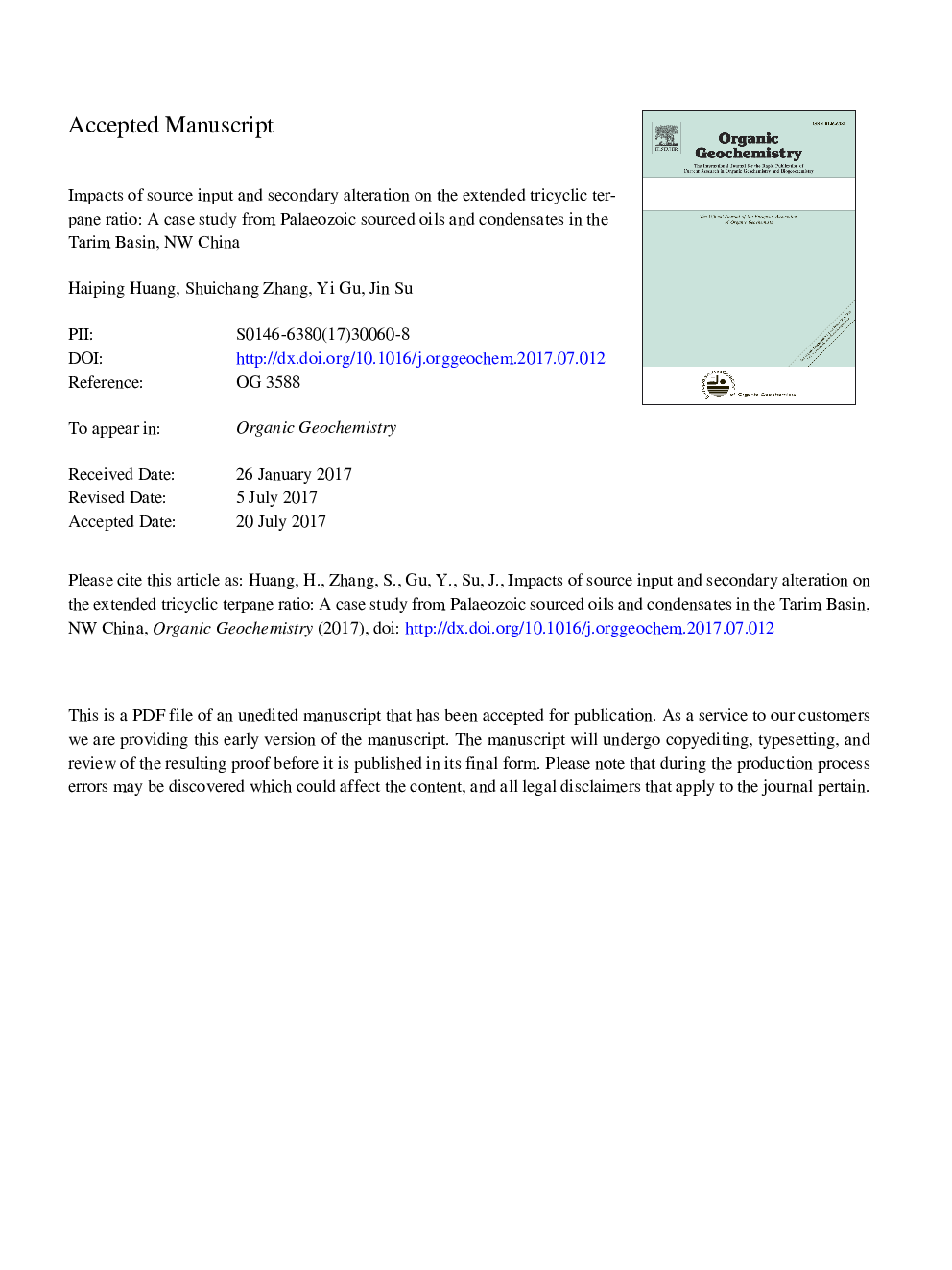| کد مقاله | کد نشریه | سال انتشار | مقاله انگلیسی | نسخه تمام متن |
|---|---|---|---|---|
| 5161421 | 1502251 | 2017 | 46 صفحه PDF | دانلود رایگان |
عنوان انگلیسی مقاله ISI
Impacts of source input and secondary alteration on the extended tricyclic terpane ratio: A case study from Palaeozoic sourced oils and condensates in the Tarim Basin, NW China
دانلود مقاله + سفارش ترجمه
دانلود مقاله ISI انگلیسی
رایگان برای ایرانیان
کلمات کلیدی
موضوعات مرتبط
مهندسی و علوم پایه
شیمی
شیمی آلی
پیش نمایش صفحه اول مقاله

چکیده انگلیسی
A suite of oils and condensates from Cambrian-Ordovician sources in the cratonic region of the Tarim Basin, NW China has been characterized by gas chromatography-mass spectrometry with a focus on factors affecting the extended tricyclic terpane ratio [ETR = (C28 + C29)TT/Ts]. These oils and condensates show ETR values ranging from 0.3 to 12.4, suggesting variable source contributions deposited under different environmental conditions. Coupled with tri- and tetracyclic terpane distributions, ETR can be used as an organofacies discriminator. Most of the samples have high ETR values (> 2.0), a low relative abundance of the C19 tricyclic terpane (C19TT) and the C24 tetracyclic terpane (C24TeT) characteristic of a clastic marine depositional environment, possibly with upwelling conditions. A specific organofacies for a few samples is characterized by low ETR values (< 2.0), high C19TT/C23TT (> 0.8) and C24TeT/C26TT (> 1.0) ratios reflecting deposition under dysoxic conditions. However, various other alteration processes such as thermal maturity, thermochemical sulfate reduction (TSR), biodegradation and in-reservoir mixing probably have a significant impact on this parameter, which makes understanding the meaning of the ETR complicated. The effect of thermal maturity on ETR is minimal in the oil generation window, but the ETR values decrease dramatically at the post oil generation stage. TSR seems to preferentially lead to the loss of the C28TT and C29TT before the 18α(H)-22,29,30-trisnorneohopane (Ts) and thus the ETR value decreases as TSR progresses. While the dibenzothiophene/phenanthrene ratio can help to differentiate TSR alteration from thermal cracking processes, the ETR is no longer a valid geochemical parameter when these two processes occur. ETR also increases with biodegradation. The C28 and C29TT are more resistant to biodegradation than Ts. Supporting evidence can be derived from a positive correlation between ETR and C29 25-norhopane to C30 hopane ratio. In-reservoir mixing is another important alteration process which normally results in lower ETR values after a fresh charge is mixed with a biodegraded charge in a reservoir. Evaporative fractionation may also have an impact on ETR values. Some unusually high ETR values might be attributed to evaporative fractionation. The ETR values from our case study suggests that the ETR parameter is much more complicated than just being an age-diagnostic parameter. Maturation and secondary alteration processes need to be fully accounted for before the ETR can be properly applied to interpretations of depositional environment conditions such as upwelling.
ناشر
Database: Elsevier - ScienceDirect (ساینس دایرکت)
Journal: Organic Geochemistry - Volume 112, October 2017, Pages 158-169
Journal: Organic Geochemistry - Volume 112, October 2017, Pages 158-169
نویسندگان
Haiping Huang, Shuichang Zhang, Yi Gu, Jin Su,